Many times we have been deceived by outer looks. Sometimes it has to do with people in our surroundings, but sometimes with products that we consume. At first glance, Xiaomi Mi 3H and Airdog X3 air purifiers seem so much alike, with their tower-shaped elegant look. We cannot deny the fact that looks can sell almost anything, but let’s dig a little deeper this time.
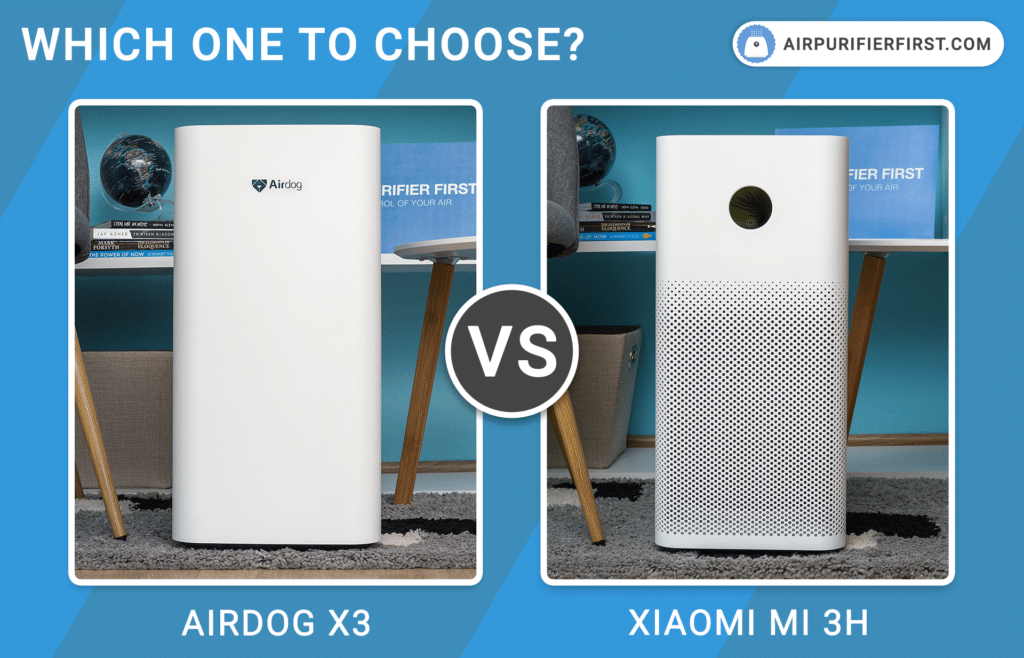
Table of Contents
This comparison should hold a SMART prefix, as these two air purifiers are both smart appliances, equipped with loads of advanced features. One of those features is definitely the Air Quality Sensor, a real-time indicator, that gives you instant information on how polluted is the air you inhale. Not only is it a useful feature, but in my opinion, also reliable data.
Another big thing about both devices is the good production material, the kind that is supposed to be dominant in all air purifiers.
However, besides having the same rectangular shape and a few other details, Xiaomi Mi 3H and Airdog X3 are pretty much individual and distinct appliances. Starting from the room coverage, which in the case of Xiaomi is almost double the size of Airdog coverage. Even though smaller in size, Xiaomi Mi 3H can cover up to 484 sq. ft. of space, while Airdog X3 can cover up to 215 sq. ft.
As you can already tell, this comparison will be about confronting an innovative technology of an ionic air purifier such as Airdog X3 and a traditional filtration system as given in Xiaomi Mi 3H. It will be a challenging path, so stick with me.
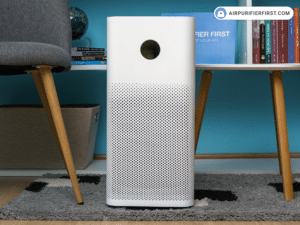 |
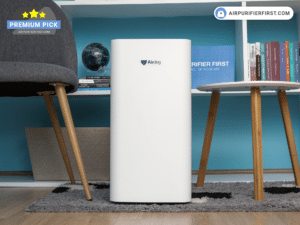 |
|
| Manufacturer | Xiaomi | Airdog |
| Model | Mi 3H | X3 |
| Dimensions | 9.45 x 9.45 x 20.47 inch | 12 x 12 x 14.5 inches |
| Weight | 11 lb | 14.33 lb |
| Coverage | 484 sq. ft. | 215 sq. ft. |
| Filters | Pre-filter, Deodorization Filter and True HEPA Filter | Pre-filter, Electrode Generator, Collecting Plate and Carbon Filter |
| Filter Reset Indicator | ||
| Filter Longevity | 6-12 months | Washable |
| Power Consumption | 38W | 27W |
| Smart Sensor | ||
| Auto Mode | ||
| Air Quality Indicator | ||
| Child Lock | ||
| Ionizer | ||
| Warranty | 1-year | 1-year |
| In-Depth Review | Xiaomi Mi 3H | Airdog X3 |
| Price | View on Amazon | View on Amazon |
Xiaomi Vs Airdog Features
A connection to a Smart App, Air Quality Sensor, Child Lock, Auto Mode are just some of the features that Airdog X3 and Xiaomi Mi 3H have installed. This proves my previous constatation of being challenged by two confronted Smart appliances and their advanced features.
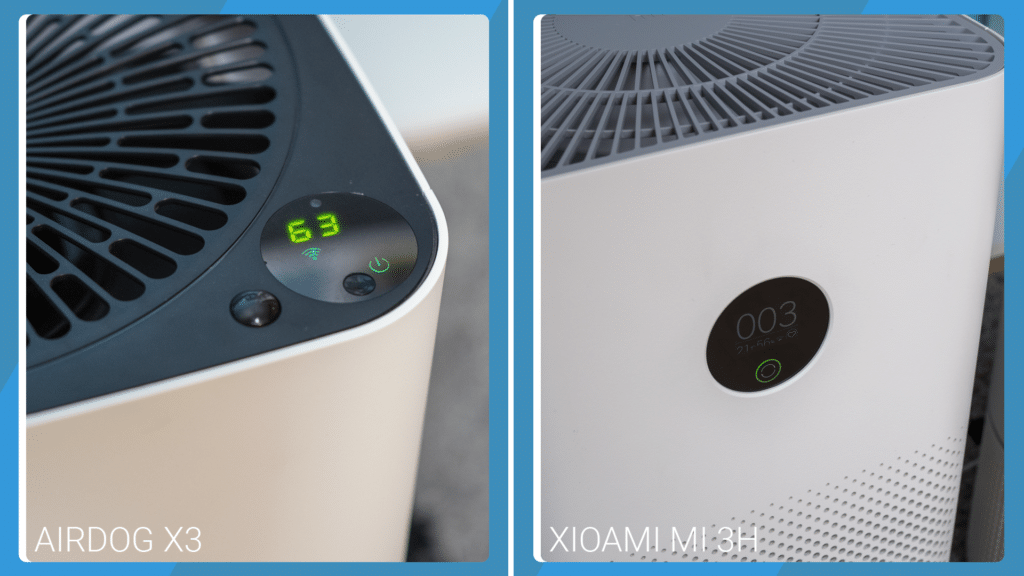
It is the modern technology that makes these appliances so attractive, and the producers are well aware of it. That is why the focus is on air quality improvement and easier device control.
With all the features that both appliances have preinstalled, out of which some are in common, this will be an interesting comparison.
Air Quality Sensor and Indicator
As I already mentioned, this is one of the features that Airdog and Xiaomi have in common, but thanks to this advanced sensor many other options are also available, such as Auto Mode, Air Quality Indicator, etc.
The Xiaomi Mi 3H air purifier has a laser particle sensor installed on the rear side. It can detect dust particles, as well as smoke and some VOCs. As expected, thanks to the same shape, Airdog X3 also has this sensor on the rear side. If you simply uncover the lid, you can approach both sensors, and wipe up the dust. As long as you keep your Xiaomi air purifier plugged in electricity, the sensor will continue to work, which means you will be able to track the air quality on your Smart App even when the air purifier is turned OFF.
A joint thing for Xiaomi and the Airdog is that, while purifying, their sensors rely on multiple installed features. After that, the result is being displayed both on the appliance and the Smart App. Xiaomi Mi 3H shows the amount of PM2.5 particles, while the Airdog shows only the real-time AQI. Don’t get confused, for these data are equally related to the air quality.
Another, I might say, the amusing thing is a color-changing indicator that both devices have. While Xiaomi has the indicator placed next to the control button, the Airdog has its indicator on the bottom side, almost as a lighting fixture. The important thing is that the indicators change colors depending on the measured air quality.
Auto Mode
One more common feature for Xiaomi Mi 3H and Airdog X3 is the Auto Mode. This is one of those features I previously talked about, that is connected to the Air Quality Sensor. The thing is, once you set your air purifier to Auto Mode, the Air Quality Sensor will measure the real-time air quality. At the same time, based on the collected data, the air purifier’s motor will adjust the speed to the most efficient level. The important thing is that with this feature, you can entirely rely on and even forget about your air purifier, and it will keep the air you inhale up to the highest standards.
Smart App
I have mentioned in previous sections Xiaomi’s and Airdog’s connectivity to a Smart App. Independently of what kind of smartphone you use, Android or iOS, you can connect both of these air purifiers to any of the Virtual Assistants available. Google Assistant or Amazon Alexa, as you wish.
These Smart Apps have the same function in each air purifier. The Airdog X3 has its own specifically designed app, while the Xiaomi Mi 3H is connected to a Mi Home app which can also be used by any of the Xiaomi family devices. I find that the Xiaomi Smart App is a pretty good developed app, with plenty of advanced features to make it easier for you to control your devices. For example, you can set the app to automatically control your air purifier in a way to turn on/off the device if the amount of PM2.5 particles rises above 25. This is just one of many options that this Smart App provides.
Nevertheless, both Smart Apps are easy to connect to and easy to use. I’ve had apps crashing many times when I tried to connect it to an air purifier. This time it didn’t happen and both Xiaomi and Airdog turned up to be bug-free.
Temperature and Humidity Meter
Having the ability to measure the temperature and humidity in the room is a feature that only Xiaomi Mi 3H has. The Airdog X3 is missing out on this option. This is just another additional feature that makes Xiaomi stand out and a very useful sensor for users who wish to have a complete picture of the air they breathe.
Manual Mode
Once you connect your air purifier to a Smart App, you will automatically turn on the Manual Mode. This means you only get to use this mode through the App, and it is available at both Xiaomi Mi 3H and Airdog X3.
What you can do with this option is to monitor the motor speed, in terms of how it runs and how the noise it produces, reflects on your living or working space. A very handy utility, that leaves you in control of your device.
Airflow
You would be right to expect that these two air purifiers have the same airflow, considering their look-alike shapes. Yet, there are minor differences and they are related to how the holes are distributed. Both Xiaomi Mi 3H and the Airdog X3 have suction holes on the bottom part of the device. The main difference is that, along with wide two-sided suction, the Xiaomi has holes on the front, while the Airdog has them on the rear part. Plus, the air openings are way smaller in Airdog than in the Xiaomi air purifier.
Warranty
I was really disappointed to see that both producers, Xiaomi and Airdog, offer only 1-year warranty coverage. Considering all the air purifiers I have had tested, with five-ten years of warranty or even a lifetime coverage, this is extremely low protection and assurance. In my opinion, both Xiaomi Mi 3H and Airdog X3 should’ve been given a longer warranty by their manufacturers, at least to justify the brand.
Filtration Technology
Unlike other features these two air purifiers have in common, the filtration technology is the most distinctive part between Xiaomi Mi 3H and the Airdog X3.
While Xiaomi uses a three-stage filtration, the Airdog has four filters, out of which three are washable.
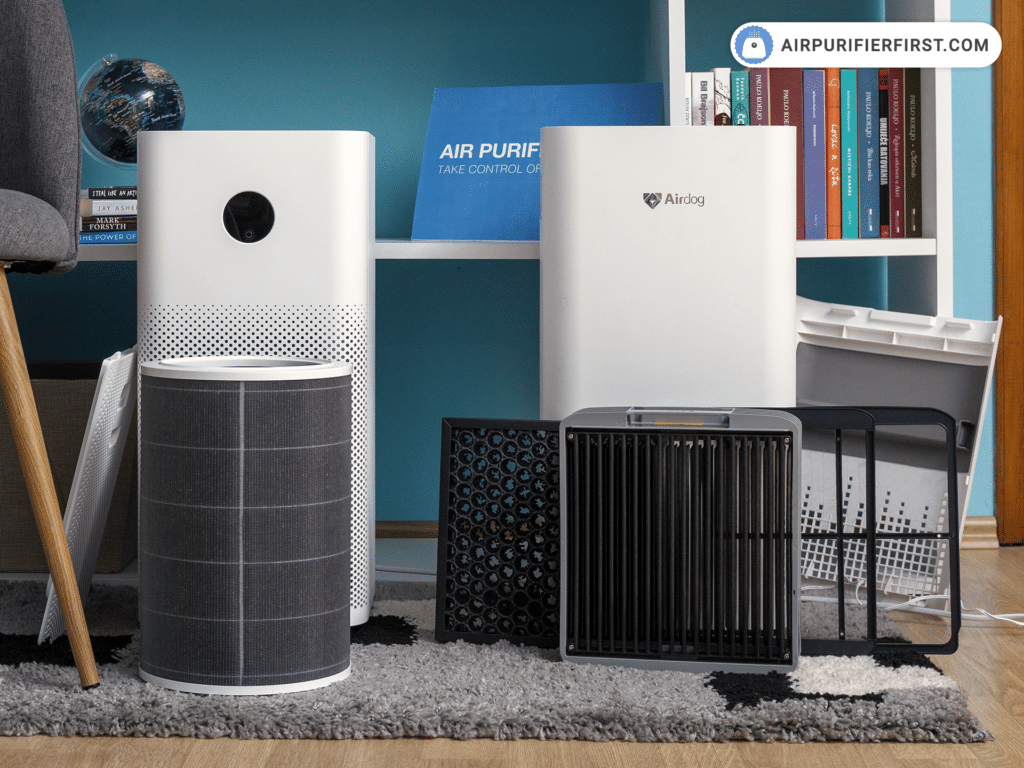
The first place is assigned for the pre-filter, which in both cases is the first line of defense, that collects all the larger particles. This filter will prevent other filters from an excessive amount of pollutants.
A True HEPA filter takes second place in Xiaomi’s filtration process, and being the most important filter, it can eliminate from the air the cigarette smoke, PM2.5 particles, pollen, dust, pet dander, and other allergens as small as 0.3 microns. The Electrode Generator is the second filter in Airdog X3, mostly dedicated to viruses and bacteria elimination.
Designed to neutralize the odors, the carbon filter takes third place in the Xiaomi Mi 3H air purifier’s filtration process. While saving the fourth place to its carbon filter, the Airdog has a third-place reserved for Collecting Plates that can dry everything that previous filters didn’t, and do it in less than 20 minutes. The particles that this filter attracts are as small as 0.0146µm, which is six times more powerful than any other more traditional air purifier can do.
If you could witness the amount of dust that these Collecting Plates can adsorb and hold during one-time usage, you would be as stunned as I was, the first time I used it.
As the final filtration stage, the Airdog has a carbon filter installed, and as I previously said, it is the only filter that cannot be washed but can be replaced. But, before you do that, you can regenerate this filter by directly exposing it to the Sun rays.
As you can see, bringing to a conclusion based solely on the filtration technology would be utterly ungrateful, which is why I will leave my final judgment to a post-performance summary.
How To Replace Filter On Both These Devices?
Given the complete differentiation in filtration technologies, these air purifiers also have contrasting maintenance rituals.
At first, you may wonder how will you know when should you clean or replace any of the filters in your air purifier. Well, both air purifiers have a Filter Reset Indicator, though very distinctive. In the case of the Airdog X3, the Filter Reset Indicator will warn you that you should clean the Collecting Plates, but in Xiaomi’s case, this indicator will light up when it’s time to replace all filters.
Like I said before you decide it’s time to completely replace it, you should leave it in the sun every once in a while, if nothing else, then give it a second chance to reach its full potential. As for the other Airdog filters, just be regular at washing them, and you will have no problem whatsoever.
Noise
As opposed to Xiaomi Mi 3H with its 3-speed levels, plus the Manual Mode, the Airdog X3 has 4 levels of speed. But, the common thing to both air purifiers, is the Sleep Mode, which is always a good option to have. I had them both tested while in Sleep Mode and, as it turned out, both tests showed me almost the same result. With 40.9 dBA created by Airdog X3 and 40.8 dBA ba Xiaomi, these appliances are amongst the most silent ones I had the opportunity to try out so far. It’s the sound of the motor running smoothly, that makes these appliances barely noticeable. No crackings, buzzing, or anything like that.
| Product | Noise Range (dBA) |
|---|---|
| Airdog X3 | 40.8 – 56.1 dBA |
| Xiaomi Mi 3H | 40.9 – 65.4 dBA |
As for the top speed level, both air purifiers are a bit louder, especially Xiaomi with 65.4 dBA created. Still, the Airdog has managed to create far less noise with only 56.1 dBA while running on top speed.
With all these results in front of me, I’ve come to a conclusion that the Airdog X3 is far less noisy than the Xiaomi Mi 3H, generally speaking.
Performance
Speaking of performance tests, you have to keep in mind that both air purifiers are pretty powerful. Yet, the challenging part of these tests was the fact that both are designed for very contrasting room sizes. While Xiaomi Mi 3H can cover up to 484 sq. ft. of space, the Airdog X3 can cover twice the smaller room size, up to 215 sq. ft.
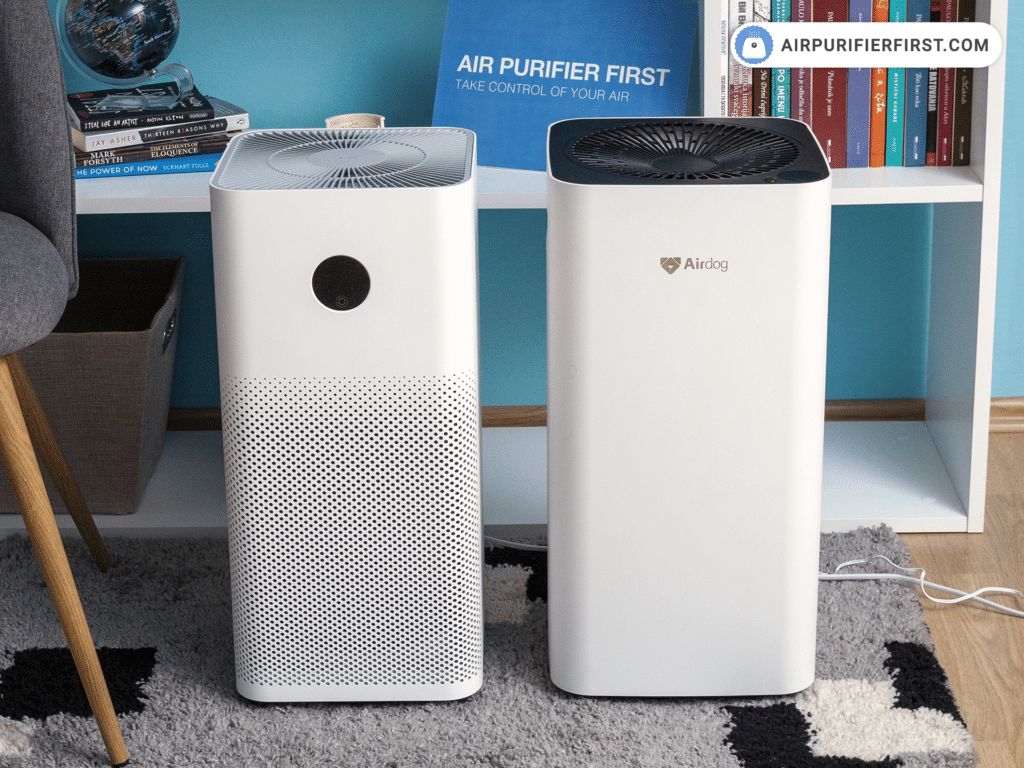
Don’t get confused by the fact that these devices have almost the same size. The fact is that Xiaomi’s motor is way more optimized, which allows this air purifier to have larger room coverage.
Now, let’s see the results of some of the tests I conducted to complete the whole picture.
320 sq. ft. Room Test
As for the first test, I decided to test both air purifiers in a 320 sq. ft. room size. I find that this size is optimal to test both devices, and I was right.
320 sq. ft. Room
* Data measuring time is 60 minutes.
With air improvement results of 95% with the use of Xiaomi and 91% with Airdog, the test was more than successful. The air quality turned out as significantly improved by both air purifiers.
Other Tests
When comparing two air purifiers that are designed for extremely opposed room sizes, I like to make sort of backup tests, just to see how each appliance would react in the designated environment. As I always do, I had both devices running on top speed during a 60-minute test.
The final result for the Airdog X3 was 93% cleaner air in a 194 sq. ft. room. On the other side, Xiaomi has improved the air quality by 90% in 560 sq. ft. room size, which is a bit more than recommended.
The overall conclusion is that both appliances showed outstanding performances and terrific results. Even though quite contrasting, the filtration technology in both appliances turned out to be more than just complex. No matter which one air purifier you choose, know that it will definitely make your living or working space a lot cleaner and your air quality at its best.
However, I will give a minor advantage to the Xiaomi Mi 3H thanks to slightly better performance.
Operating Costs
Let me start by saying the obvious: when it comes to maintenance I’m not sure that many air purifiers can measure up to Airdog X3. Just the simple fact that filters are washable, minimizes the costs to zero. Compared to quite an expensive filter replacement in Xiaomi Mi 3H, it is clear which device is more affordable.
Let’s say you leave both air purifiers running at maximum speed, 24/7 for a whole month. You will end up with a 3.4$ bill for an electricity consumption made by Xiaomi’s 38W motor. On the other side, it will cost you 2.1$ to leave the Airdog’s 27W motor running the whole time.
| Product | Wattage Range (W) |
|---|---|
| Airdog X3 | 1.8 – 24.1W |
| Xiaomi Mi 3H | 0.9 – 39W |
Given that the usage of the carbon filter is subjective, Airdog turns out as a super affordable solution for an air purifier.
Which One Does It Better?
To summarize it all: we have two powerful and very modern air purifiers, with look-alike and really elegant design, both equipped with a bunch of advanced features. Somehow it turns out that always the shades overrule in favor of the winner. But, this time, shades got me confused.
Based on my previous experience, I would most likely choose the Xiaomi Mi 3H. I am a big fan of the True HEPA technology, that this air purifier uses. Plus, you can’t disregard the benefits of a powerful Smart App, added innovative sensors, and the fact of a longtime market presence, that sets the value to the product.
However, if I were to think long-term, by keeping in mind total costs, I would choose the Airdog X3 air purifier. Although it feels like an expensive gadget at first, look at it as a long-term investment. It costs nothing to replace the filters and it decreases your electricity expenses to a minimum. Besides, compared to Xiaomi Mi 3H, you get a really quieter device, even at maximum speed level.
Without further ado, I would have to call it a draw because having such extraordinary and powerful appliances is always a good choice. Even more so with knowing it will provide you a good quality of the air you breathe. There is no substitute for clean air or good health.
Whether you agree or disagree with me, I sure would like to hear more from you. So, don’t hesitate and type your opinion in the comments section below.
Leave a Reply